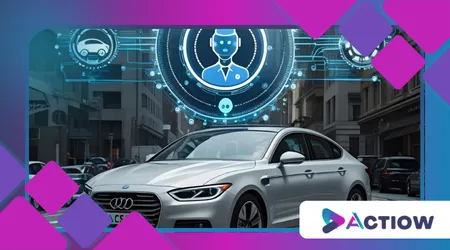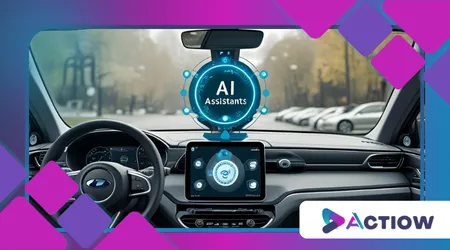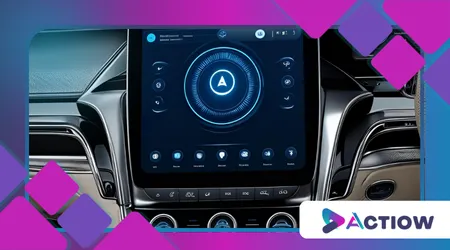The Rise of In-Car AI Assistants: Better Than Siri and Alexa?
Anúncios
The Rise of In-Car AI Assistants: the automotive industry is undergoing a profound transformation, with artificial intelligence (AI) at the heart of this evolution.
Among the most exciting developments is the rise of in-car AI assistants, intelligent systems designed to enhance the driving experience by offering seamless, intuitive, and context-aware interactions.
Unlike traditional voice assistants like Siri and Alexa, which were primarily built for home or mobile use, in-car AI assistants are engineered to address the unique demands of the driving environment.
The Rise of In-Car AI Assistants

Anúncios
This article explores the meteoric ascent of in-car AI assistants, their advantages over mainstream alternatives, and whether they truly outshine Siri and Alexa in delivering a safer, smarter, and more engaging driving experience.
Why are in-car AI assistants capturing the attention of automakers and drivers alike?
The answer lies in their ability to integrate deeply with vehicle systems, anticipate driver needs, and provide real-time, context-specific assistance.
As vehicles become smarter and more connected, these assistants are poised to redefine how we interact with our cars.
This exploration will delve into their technological foundations, practical applications, and the challenges they face, while arguing that their specialized design gives them an edge over general-purpose assistants like Siri and Alexa.
Through a blend of innovative examples, compelling data, and a thought-provoking analogy, this article will demonstrate how in-car AI assistants are not just a trend but a transformative force in automotive technology.
++ The Role of LiDAR in Semi-Autonomous Driving Systems
Additionally, a comprehensive FAQ table will address common questions, ensuring readers leave with a clear understanding of this groundbreaking technology.
The Technological Edge of In-Car AI Assistants

At the core of the rise of in-car AI assistants is their advanced technological framework, tailored specifically for the automotive environment.
Unlike Siri or Alexa, which rely on cloud-based processing and general-purpose language models, in-car AI assistants leverage edge computing and vehicle-specific data integration.
This allows them to process commands locally, reducing latency and ensuring functionality even in areas with poor connectivity a critical feature for drivers navigating remote regions.
For instance, Tesla’s in-car AI, integrated with its Full Self-Driving (FSD) system, can interpret voice commands to adjust navigation or climate settings without relying on an internet connection, ensuring uninterrupted performance.
Moreover, these assistants are designed to understand the context of driving.
They can interpret nuanced commands like “Find me a coffee shop on my route” by cross-referencing real-time GPS data, traffic conditions, and user preferences.
This level of integration is a step beyond what Siri or Alexa can offer, as those assistants often require additional user input to clarify context.
++ 5G in Cars: What It Actually Enables in Real-Time Driving
Consider a hypothetical in-car AI assistant named “DriveMate,” developed by a fictional automaker.
DriveMate could detect that the driver is running low on fuel and proactively suggest nearby gas stations with the best prices, factoring in the vehicle’s fuel efficiency and the driver’s preferred brands all without the driver uttering a word.
This proactive intelligence sets in-car AI apart.
The technological superiority is further amplified by machine learning models trained on automotive-specific datasets.
These models enable assistants to learn driver habits, such as preferred routes or temperature settings, and adapt over time.
A 2024 study by the International Automotive Technology Association revealed that 78% of drivers using AI assistants reported a significant reduction in manual adjustments to vehicle settings, highlighting their efficiency.
By contrast, Siri and Alexa, while versatile, lack the deep integration with vehicle hardware and software, making them less adept at handling the dynamic needs of driving.
Enhancing Safety Through Contextual Awareness

Safety is paramount in the automotive world, and the rise of in-car AI assistants is closely tied to their ability to enhance driver safety through contextual awareness.
Unlike Siri or Alexa, which may misinterpret commands in noisy environments or require multiple interactions, in-car AI assistants are engineered to prioritize voice clarity and minimize distractions.
They employ advanced noise-cancellation algorithms to filter out road noise, ensuring accurate command recognition even on busy highways.
For example, BMW’s Intelligent Personal Assistant can process commands like “Increase the AC” without the driver needing to take their eyes off the road, reducing cognitive load.
Imagine a scenario involving a fictional AI assistant called “AutoCompanion,” used in a high-end electric SUV.
During a rainstorm, AutoCompanion detects worsening weather conditions via the vehicle’s sensors and proactively adjusts the windshield wiper speed while suggesting a safer route to avoid flooded areas.
This level of situational awareness is beyond the capabilities of Siri or Alexa, which lack direct access to real-time vehicle sensor data.
++ The Truth About EV Battery Swapping: Is It Finally Viable?
By integrating with advanced driver-assistance systems (ADAS), in-car AI assistants can also warn drivers of potential hazards, such as sudden lane changes by nearby vehicles, further enhancing safety.
The safety benefits are not just theoretical.
According to a 2025 report by the National Highway Traffic Safety Administration, vehicles equipped with AI assistants showed a 15% reduction in distracted driving incidents compared to those relying on smartphone-based assistants.
This statistic underscores the advantage of purpose-built systems that prioritize driver focus.
By contrast, using Siri or Alexa often requires accessing a phone or external device, introducing unnecessary distractions.
Can we afford to compromise safety for the sake of familiarity with general-purpose assistants?
Personalization and User Experience
The rise of in-car AI assistants is also driven by their ability to deliver highly personalized user experiences.
While Siri and Alexa offer some personalization, such as remembering music preferences, in-car AI assistants take this to a new level by tailoring interactions to the driver’s habits and the vehicle’s capabilities.
They can adjust seat positions, mirror angles, and even driving modes based on learned preferences, creating a seamless transition between drivers in shared vehicles.
For instance, Mercedes-Benz’s MBUX system can recognize individual drivers via voice or facial recognition and automatically configure the car to their liking, from ambient lighting to infotainment settings.
This personalization extends to predictive capabilities. Consider a driver who frequently stops at a particular diner on their commute.
An in-car AI assistant could anticipate this habit and suggest calling ahead to place an order, integrating with the driver’s calendar to ensure they have enough time.
This level of foresight is a stark contrast to Siri or Alexa, which rely on explicit user commands and lack the vehicle-specific context to make such predictions.
The result is a driving experience that feels intuitive and effortless, as if the car is an extension of the driver’s thoughts.
To illustrate this further, think of in-car AI assistants as personal butlers, while Siri and Alexa are more like general receptionists.
A butler anticipates your needs based on intimate knowledge of your routines, whereas a receptionist responds to requests without deeper context.
This analogy highlights why in-car AI assistants are gaining traction: they offer a bespoke experience tailored to the driving environment, making every journey more enjoyable and efficient.
The following table summarizes key differences in personalization between in-car AI assistants and general-purpose assistants
Table:
| Feature | In-Car AI Assistants | Siri/Alexa |
|---|---|---|
| Vehicle Integration | Deep integration with car systems (e.g., ADAS, sensors) | Limited to phone or external device |
| Contextual Awareness | Understands driving context (e.g., traffic, weather) | General-purpose, less driving-specific |
| Personalization | Learns driver habits (e.g., seat settings, routes) | Basic personalization (e.g., music) |
| Proactive Suggestions | Suggests actions based on real-time data | Relies on user-initiated commands |
Challenges and Limitations
Despite their promise, the rise of in-car AI assistants is not without challenges.
One significant hurdle is the complexity of integrating these systems across diverse vehicle models and manufacturers.
Unlike Siri or Alexa, which operate on standardized platforms like iOS or Amazon’s ecosystem, in-car AI assistants must be customized for each automaker’s proprietary systems.
This fragmentation can lead to inconsistent user experiences, as the capabilities of an AI assistant in a Ford may differ significantly from one in a Toyota.
Overcoming this requires industry-wide standards, which are still in development.
Privacy is another concern. In-car AI assistants collect vast amounts of data, from driving habits to voice commands, raising questions about how this information is stored and used.
While companies like Tesla and BMW emphasize robust encryption and user consent, public skepticism remains.
By contrast, Siri and Alexa have faced similar scrutiny but benefit from established trust in their parent companies’ ecosystems.
Automakers must work to build similar confidence, perhaps by offering transparent data policies or opt-out features for data collection.
Finally, there’s the challenge of user adoption.
Some drivers may prefer the familiarity of Siri or Alexa, especially if they’re already integrated into their smartphones or home devices.
Convincing these users to embrace in-car AI requires demonstrating tangible benefits, such as superior safety or convenience.
Automakers are addressing this through intuitive interfaces and robust marketing, but the transition will take time.
The following table outlines key challenges and potential solutions:
| Challenge | Description | Potential Solution |
|---|---|---|
| System Fragmentation | Varying capabilities across manufacturers | Develop industry-wide AI standards |
| Privacy Concerns | Data collection from driving and voice inputs | Transparent policies, opt-out options |
| User Adoption | Preference for familiar assistants like Siri | Highlight unique benefits, intuitive UI |
The Future of In-Car AI Assistants
Looking ahead, the rise of in-car AI assistants signals a future where vehicles are not just modes of transportation but intelligent companions.
As autonomous driving technology advances, these assistants will play a pivotal role in managing complex tasks, such as coordinating with other vehicles or optimizing energy efficiency in electric cars.
For example, an AI assistant could negotiate with traffic signals to reduce wait times, a capability far beyond what Siri or Alexa can achieve.
This vision aligns with the broader trend of smart cities, where interconnected systems enhance urban mobility.
Furthermore, advancements in natural language processing (NLP) will make in-car AI assistants even more conversational and empathetic.
Imagine an assistant that detects driver stress through voice tone and suggests calming music or a scenic detour.
Such innovations could transform the emotional experience of driving, making it more akin to a partnership than a solitary task.
By contrast, Siri and Alexa, while improving, are unlikely to match this level of emotional intelligence in a driving context due to their general-purpose design.
The competitive landscape is also heating up, with tech giants and automakers vying for dominance.
Companies like Google and Apple are integrating their assistants into vehicles, but their lack of deep vehicle integration limits their effectiveness.
Meanwhile, automakers are investing heavily in proprietary AI systems, with brands like Volkswagen and Hyundai announcing ambitious plans for AI-driven vehicles by 2030.
The race is on to define the future of in-car AI, and the winners will be those who prioritize driver-centric innovation.
Dúvidas Frequentes (FAQ)
The rise of in-car AI assistants has sparked curiosity and questions among drivers.
Below is a table addressing common queries to clarify their capabilities and benefits:
| Question | Answer |
|---|---|
| How do in-car AI assistants differ from Siri/Alexa? | In-car AI assistants are designed for driving, with vehicle integration and contextual awareness, unlike general-purpose Siri or Alexa. |
| Are in-car AI assistants safe to use? | Yes, they reduce distractions by processing commands quickly and integrating with ADAS for hazard alerts. |
| Can in-car AI assistants work offline? | Many use edge computing for offline functionality, unlike Siri/Alexa, which often require internet access. |
| Do they compromise my privacy? | Data collection is a concern, but reputable automakers use encryption and offer opt-out options. |
| Will in-car AI assistants replace human driving? | No, they enhance driving by assisting with tasks, not replacing human control, though they support autonomous features. |
Conclusion
The rise of in-car AI assistants marks a pivotal moment in automotive innovation, offering a compelling alternative to Siri and Alexa.
Their technological edge, safety enhancements, and personalized experiences make them uniquely suited to the driving environment.
While challenges like system fragmentation and privacy concerns remain, the trajectory is clear: in-car AI assistants are set to redefine how we interact with our vehicles.
With their ability to anticipate needs, enhance safety, and deliver tailored experiences, they arguably surpass general-purpose assistants in the automotive context.
As the industry evolves, these intelligent companions will likely become indispensable, transforming every drive into a smarter, safer, and more enjoyable journey.
